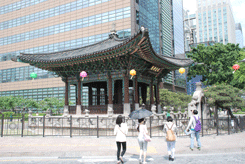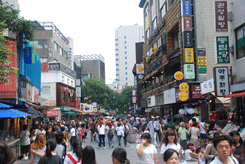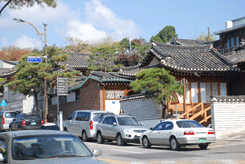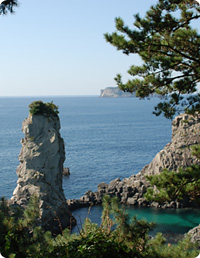WALKING
Seoul B / 5 hours



Tour Highlights
- Cheonggyecheon Stream
- Bosingak Bell Tower
- Insadong
- Jogyesa Temple
- Gwanghwamun Plaza
- Gyeongbokgung Palace
- The National Folk Museum of Korea
- Bukchon Hanok Village
Seoul (- - -)
You will explore Korea's capital city that is full of rich heritage, tradition, culture, history and tourist attractions. The tour begins at Cheonggyecheon Plaza, a 5.8km-long stream that flows through downtown Seoul. At the head of the stream stands a sculpture created by world-renowned artist Coosje Van Bruggen and Claes Oldenburg. Alongside the stream is a lively commercial district filled with numerous arcades and commercial facilities including the country's largest Dongdaemun Market. Visitors stroll around the stream and lovebirds walk slowly arm-in-arm at night when the banks are lit up.
Bosingak bell tower sits at the busy intersection . A bell from 1468 was tolled here daily to announce the opening and closing of the city gates during the Joseon Dynasty (1392-1910). Today, the bell is tolled 33 times once a year at midnight on December 31. At this occasion, a large gathering of people celebrate and welcome the coming of New Year.
Insadong, at one time the center of traditional Korean art and antiques, features a mixture of historical and modern atmosphere representing the cultural glimpse of the nation. Clustered along the main street and alleys are lined with street vendors, wooden tea houses, restaurants and numerous galleries and shops dealing in antiques, oriental art supplies, and modern Korean art of all types and styles. Soak in the paintings, upscale artworks, antiques and potteries while you can. Get lucky and you just might meet the artist themselves. It can be plenty of fun walking on the main street, but you venture into the hidden alleys that do spring some unexpected surprises. While here, you may want to buy some souvenirs or simply wander and browse at leisure admiring cultural ambience.
A block away from the alley is Jogyesa, the head temple of Jogyejong, the principal sect of Buddhism in Korea emphasizing the Zen orthodox, meditation tradition and the purity of monastic celibacy. The temple does not give off the solemn and traditional air of the other temples located deep in the mountains, but when you enter the temple the frenzy of the city start disappearing. The Main Worship Hall, Daeungjeon, holds triad Buddhas, Sakyamuni, Amitabha and Bhaisajyaraja. The figure in the center is Sakyamuni Buddha who has overcome greed, hatred and delusion. While here it is worth noting the 500 year old lacebark pine and 400 year old locust tree that still grace the property.
You will tour the pedestrian-friendly Gwanghwamun Plaza that is hemmed in on both sides by rushing traffic and office buildings. The plaza is lined on each side with 365m long streamlets, two centimeters deep and one meter across, the stone bed of the plaza's east side waterway engraved with important events in chronological order from 1392 to 2008.
Standing high on a stone pillar is a statue of Yi Sunsin who had engaged in twenty-three naval battles and emerged victorious in all of them during the Hideyoshi invasion (1592-1598). King Sejong who propagated the Korean alphabet in the 15th century is also honored with prominent statue. On August 16, 2014, Pope Francis celebrated Mass in this plaza to beatify 124 Korean martyrs. Near the southwest corner of the plaza is Korea's Kilometer Zero, marking the distances to 64 cities around the world, including Seoul's antipode, Montevideo, Uruguay, 19,606km..
Step back in time to when life was gracefully slow and discover Gyeongbokgung Palace, a particularly charming spot that represents a colorful and turbulent side of the capital's 500-year history. Depending on timing, you may witness the Royal Guard Changing Ceremony featuring parade, password verification, duty shift and patrolling the gate. Accompanied by a court band with its colorful costumes and royal flags, the ceremony is performed daily basis at 10:00 and 14:00 except Tuesdays, although it is cancelled in case of rain or extremely hot or cold weather.
Up from the gates is a spacious stone-paved courtyard that is fully enclosed by wooden cloisters, and at the center of which runs three footpaths through two rows of rank stones, indicating the positions of the officials with the highest rank being closer to the hall.
Standing majestically on top of a two-tiered stone platform that is lined with detailed balustrades is Geunjeongjeon Hall, where the king formally granted audiences to his officials, gave declarations of national importance, presided over large official functions, and greeted foreign envoys and ambassadors. Check out the royal throne and a large painting, depicting sun, moon, five peaks, streams and pine trees, which was the crucial signifier of the king. And up in the center of the ceiling, the bright golden dragons in bold relief indicate the presence of the king.
At the back of the throne hall is a group of court offices. Displayed in front of the King's official quarters is sundial, conceived in order to catch the shadow of the sun, which tells time and 24 periods of seasonal change from the winter solstice to the summer solstice.
Sitting on the island in the rectangular lake is Gyeonghoeru. Supported by 48 square and cylindrical massive stone pillars representing the idea of Yin and Yang, this magnificent pavilion was used for many purposes ranging from receptions to national examinations.
Gangnyeongjeon is the king's sleeping and living quarters while Gyotaejeon is the queen's domain containing a number of halls. The noted feature of these main buildings is an absence of a top roof ridge.
Amisan Garden, landscaped with four hexagonal chimneys in orange bricks, is seldom noticed by the hurried visitors. Jagyeongjeon is the queen dowager's residence. Although less colorful, it is worth noting the wall, adorned with floral designs and the chimneys with ten longevity symbols.
Hyangwonjeong features a small pond with a manmade islet that supports a beautiful two-story pavilion. Behind this serene garden is Geoncheonggung, where the king and queen could relax in peace and quiet. It was here that the first electric lights in the country were installed in 1887 in 8 years of Thomas Edison's invention and a tragic chapter in Korea's history was recorded when empress Myeongseong was assassinated by the sword-bearing Japanese assassins in the early morning of 8 October 1895, allegedly under orders from Miura Goro.
Upon exiting the Sinmumun gate, you will take a few minutes to take some pictures in front of the Blue House, the executive office and official residence of the president of Korea. Then back into the palace and learn about the cultural wealth of this friendly and picturesque nation at The National Folk Museum of Korea showcasing life and work, costumes and ornaments, handicrafts and technology, educations, living quarters, dietary life, oriental medicine, performing arts and games, beliefs and rituals, and socio cultural life of the Korean people from the prehistoric age to the Joseon Dynasty.
Later, you will experience a unique view of Bukchon Hanok Village as you wander through the maze of alleys that wind and twist between houses, making you eager to see what you will find next. The quaint neighborhood hangs on tenaciously to its traditional past. The sight of a number of houses built next to each other, sharing a wall and touching each other's eaves is a fascinating glimpse into the friendly and open-hearted lifestyle of Koreans.






